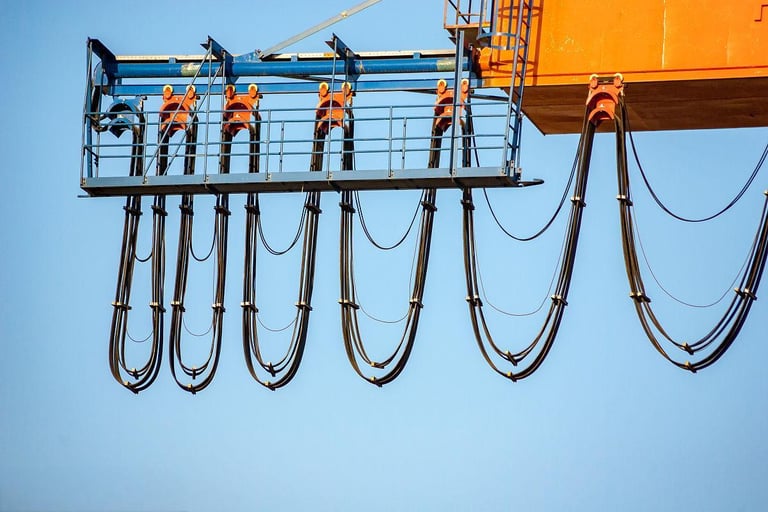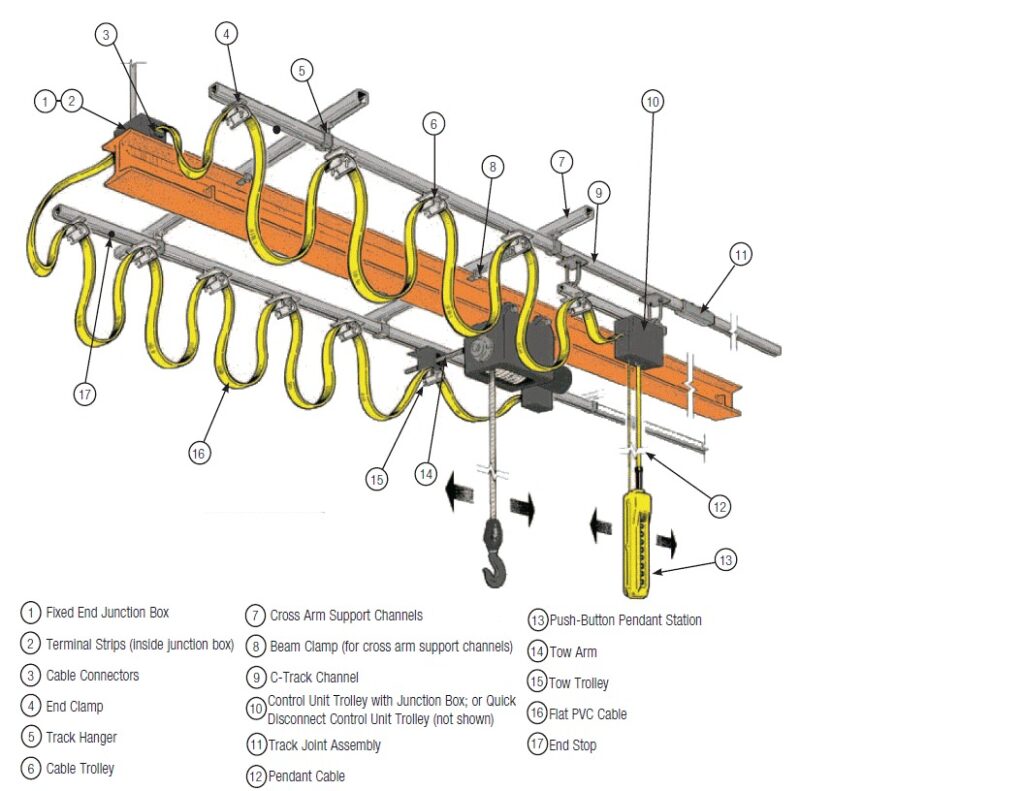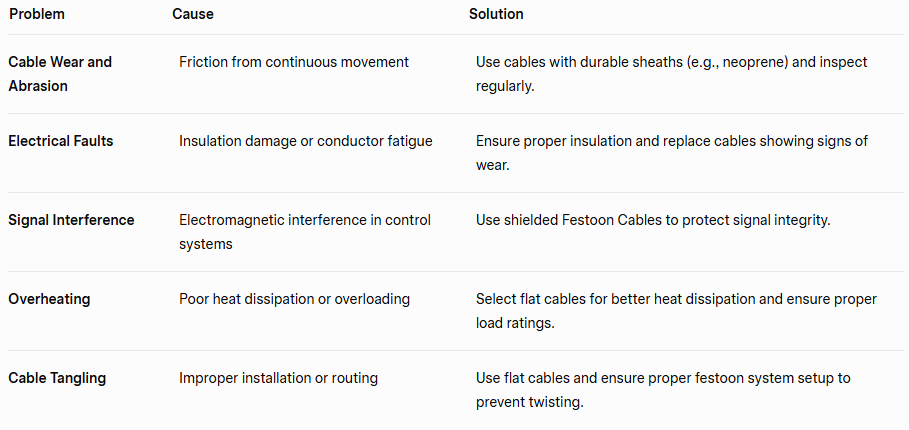📞+86 153 7530 2641 📧 hongjing.Wang@feichuncables.com

Basic Concepts and Working Principles of Festoon Cable and Its Application in Port Environments
In-depth understanding of Festoon Cable suspension power supply system: working principle, technical characteristics, and application advantages. Professional analysis of the key role of busbar cable in port cranes and factory automation to help you choose the most suitable mobile power supply solution. Tailored for industries seeking reliable and efficient cable solutions.
hongjing.Wang@Feichun
7/7/20255 min read
Introduction
Festoon Cables are a cornerstone of modern industrial automation, particularly in environments requiring continuous motion, such as port cranes, manufacturing lines, and material handling systems. These cables are engineered to deliver power and control signals to mobile equipment while withstanding the stresses of repeated bending, harsh environmental conditions, and heavy mechanical loads. In Australia, where industries like shipping, mining, and manufacturing thrive, Festoon Cables play a critical role in ensuring operational efficiency and safety.
This article explores the fundamental concepts and working principles of Festoon Cables, with a particular focus on their applications in port environments. We’ll delve into their structure, types, advantages, and selection considerations, while also addressing common questions about potential cable issues and their solutions. By understanding these aspects, Australian businesses can make informed decisions to optimize their operations.


What is Festoon Cable?
Festoon Cable is a specialized, highly flexible cable designed for applications involving continuous motion, such as cranes, hoists, and conveyors. The term "festoon" refers to the cable’s suspension in a curved, draped configuration between two points, allowing it to move smoothly without tangling or twisting. This design is particularly suited for equipment that travels along tracks or rails, ensuring a reliable power and signal supply.
Key Features
High Flexibility: Festoon Cables are constructed with multi-strand copper conductors, often with 100 or more strands, to ensure flexibility and resistance to fatigue from repeated bending.
Wear Resistance: The cables are built to withstand abrasion, making them durable in rugged industrial settings.
Tensile Strength: They can endure significant tension, critical for applications like port cranes lifting heavy loads.
Environmental Resistance: Materials like neoprene or PVC provide resistance to oil, chemicals, UV radiation, and extreme temperatures, making them suitable for both indoor and outdoor use.
Application Fields of Festoon Cable
Festoon Cables are versatile and widely used across various industries, with significant applications in:
Port Cranes: In Australian ports like the Port of Melbourne or Fremantle, Festoon Cables power container cranes, ensuring seamless loading and unloading of cargo. Their ability to move with the crane while maintaining a stable connection is vital for operational efficiency.
Industrial Manufacturing: In factories, these cables support assembly lines, robotic arms, and conveyors, enabling continuous motion without compromising power delivery.
Lumber Mills and Jetways: Used in lumber mills for moving equipment and in airport jetways for aircraft servicing, ensuring reliable power in dynamic environments.
Automotive Manufacturing: Festoon Cables power robotic arms in car manufacturing plants, supporting precise and rapid assembly processes.
In port environments, Festoon Cables are particularly valuable due to their ability to withstand harsh coastal conditions, including salt corrosion, high humidity, and UV exposure, which are common in Australia’s maritime industry.


Structure and Types of Festoon Cable
Structural Composition
Festoon Cables are engineered with a multi-layered structure to ensure durability and performance:
Conductors: Made of multi-strand copper wire for high conductivity and flexibility. For example, a 10 AWG Festoon Cable may contain 100 strands of 36 AWG wire, enhancing its ability to flex without breaking.
Insulation Layer: Typically made of neoprene or PVC, resistant to oil, wear, and temperatures ranging from -50°C to 105°C. This layer prevents electrical leakage and ensures safety.
Sheath: The outer layer, often double-jacketed in harsh environments, protects against moisture, chemicals, and physical damage, extending the cable’s lifespan.
Common Types
Type
Round Cable
Flat Cable
Shielded Cable
Applicable Scenarios
Features
General mobile equipment
Rail pulley systems
Environments with electromagnetic interference
High flexibility, easy installation
Space-saving, good heat dissipation
Strong anti-interference ability
Round Cable: Ideal for applications requiring three-dimensional movement, such as overhead cranes.
Flat Cable: Preferred in space-constrained environments like narrow crane runways, offering efficient heat dissipation and reduced tangling.
Shielded Cable: Used in settings with high electromagnetic interference, such as automated manufacturing, to ensure signal integrity.
Advantages of Festoon Cable
Festoon Cables offer several benefits that make them indispensable in industrial applications:
High Flexibility: Their high strand count and flat design allow them to endure frequent bending without damage, critical for continuous motion systems.
Strong Durability: Materials like neoprene and PVC resist wear, oil, corrosion, and UV radiation, ensuring longevity in harsh conditions like Australian ports.
Safe and Reliable: Multiple protective layers reduce the risk of electrical faults, enhancing safety in critical applications like crane operations.
Easy Installation and Maintenance: Compatible with various rail pulley systems, Festoon Cables are straightforward to install and maintain, minimizing downtime.
Selection and Installation Precautions
Selecting and installing Festoon Cables requires careful consideration to ensure optimal performance:
Model Selection: Choose the cable type based on the equipment’s movement distance and speed. Flat cables are ideal for compact spaces, while round cables suit broader movements.
Environmental Factors: In Australia’s coastal ports, select neoprene cables for resistance to salt corrosion and UV exposure. PVC cables may suffice for indoor or less harsh environments.
Bending Radius and Tension: Adhere to the cable’s minimum bending radius (typically 6 times the cable diameter) and avoid excessive tension to prevent damage.
Regular Maintenance: Inspect cables every six months for wear, aging, or damage, especially in high-usage environments like ports, and replace them promptly to avoid failures.
Common Cable Problems and Solutions
Festoon Cables, while robust, can encounter issues in demanding environments. Below are common problems and their solutions:


Q&A on Potential Cable Problems
Q: Why does my Festoon Cable wear out quickly in a port environment?
A: Coastal environments expose cables to salt, moisture, and UV radiation. Choose neoprene cables for enhanced durability and conduct regular inspections to catch wear early.
Q: How can I prevent signal interference in automated systems?
A: Opt for shielded Festoon Cables, which have additional layers to block electromagnetic interference, ensuring reliable control signals.
Q: What causes cable overheating, and how can it be avoided?
A: Overheating may result from overloading or poor heat dissipation. Ensure the cable’s load rating matches the application and consider flat cables for better heat management.
Q: How often should Festoon Cables be replaced?
A: Replacement depends on usage and environment. In high-usage settings like ports, inspect every six months and replace cables showing significant wear or damage.
Future Development Trends
The Festoon Cable industry is evolving to meet modern industrial demands:
Material Upgrades: Manufacturers are developing cables with advanced materials like thermoplastic elastomers (TPE), offering improved flexibility and environmental resistance. These materials are also more sustainable, aligning with Australia’s focus on eco-friendly practices.
Intelligent Monitoring: Integration of sensors for real-time monitoring of cable conditions, such as strain and temperature, enables predictive maintenance, reducing downtime in critical applications like port operations.
Customized Solutions: Tailored cables for specific industries, such as those Ascertain the cable’s suitability for the equipment’s movement and environmental conditions. For instance, in Australian ports, cables can be customized to withstand salt corrosion and UV exposure.
Conclusion
Festoon Cables are a vital component in industrial automation, particularly in dynamic environments like Australian ports, where they ensure reliable power and signal delivery for mobile equipment. Their high flexibility, durability, and environmental resistance make them ideal for demanding applications. By carefully selecting the appropriate cable type, adhering to installation best practices, and addressing common issues like wear and interference, businesses can maximize operational efficiency and safety. As technology advances, Festoon Cables will continue to evolve, incorporating advanced materials and intelligent monitoring to meet the needs of modern industries.
How to Reach Us
Get in Touch
SiteMap
Product Catalogue
Reeling Cable
Festoon Cable
Shore Power Cable




Scan to add us on WeChat
